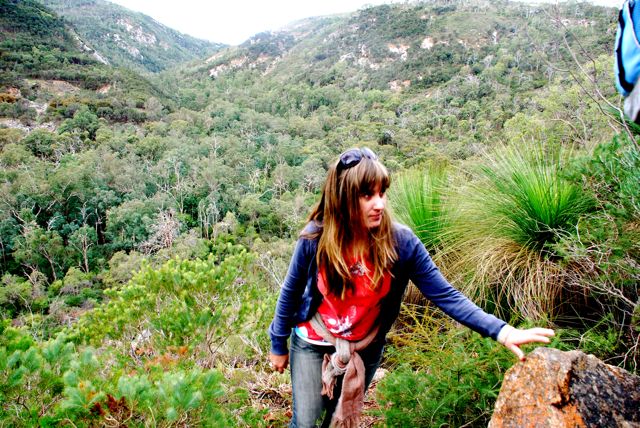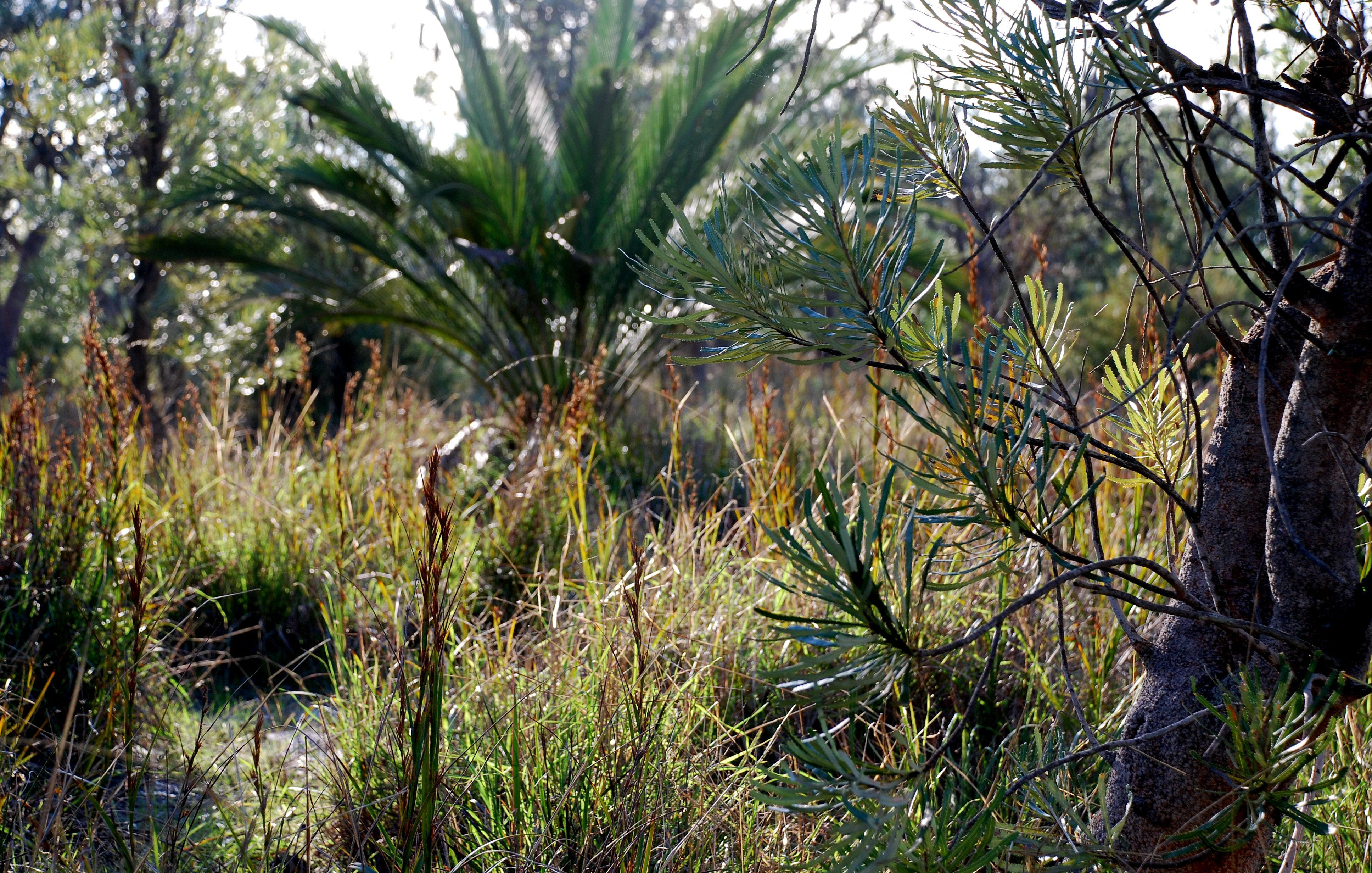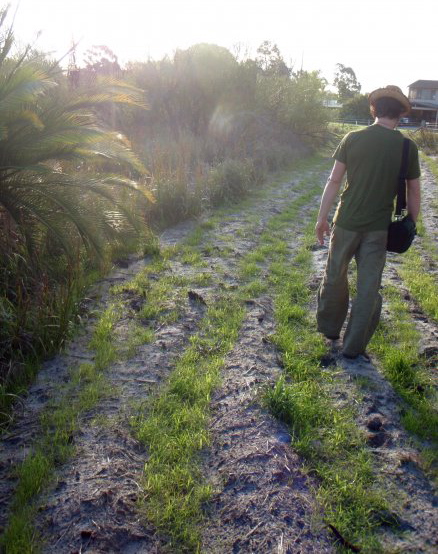It has rained a lot recently, or so it seems to me. And yet in fact the first half of 2009 has been much drier than average in Perth, in line with this corner of the world getting less and less rainfall as global climate change takes its toll. Political weather… Now we’re moving into July, which is the wettest and coldest month of the year in Perth. But with maximums of 18 degrees for July I shouldn’t really complain (although most people I know seem to do that) It is true that I’ve been inside for the last few weeks more than I like to be. Yesterday I bucked the trend.
Off to Wungong Gorge on the edge of the Darling Ranges with a few friends. We walked up the gorge on the track, imprinted as it is with a few horses’s hoof marks, but not much else. As we moved away from the road the green grass carpeting the hill that dropped away to our south came as a surprise to my eyes, so unaccustomed as I am to seeing such an intensity of the colour green in this part of Australia. After twenty minutes or so we left the track and climbed up through some Marri trees, sheoaks, and grass trees on the southern side of the gorge. This was steep terrain and little plants clung to the slope. Small Drosera species, or sundews, were waving their vivid and alien arms down at ground level, bedecked with false nectar to entice insects in for a feed (once the carnivarous sundew has the insect on board the sundew is the only one to be doing the feeding). We scrambled up some loose rocks and then climbed a granite dome. There we sat and looked back down over the peaceful treasure trove of unsullied nature beneath us. The natural world… The magna mater.
Valleys like this are like cantonments of biological diversity away from the strife of bulldozers and anti-nature shire councilors down on the Swan Coastal Plain. Later, after returning to the valley floor we found a place to swim in Wungong brook. The water was an icy shock to the system, but after getting out the grey July air suddenly seemed warm and relaxing. There is something congruent in removing human-built artifacts from one’s sight, and removing other human-built artifacts, clothes, from one’s frame. A journey up a stone gorge then becomes a trip back to primary elements. Simplify, simplify, simplify, wrote Thoreau… and a day trip to the Darling Scarp becomes a balm to the over-perplexed urban iPodder.
I found the dead trunk of an old balga (grass tree) and, in my Nyoongar-taught enthusiasm to find white larvae to eat I kicked it in half. A lizard, I think an ornate rock dragon, tumbled out, but no bush tucker. I guess the old Australians would just eat the lizard, but I felt sorry for the poor fella. He had been snug and thermally insulated in this old balga trunk, and ready to return to this beautiful hillside once things warmed up. Some stupid ape out of Africa had disturbed his winter shut-eye. I was repentant.
As the afternoon lengthened we returned to the Swan coastal plain to the west. Stopping at the end of a suburban street by Forrestdale Lake, we planned to wander through some swamplands. Forrestdale Lake used to be called Jandakot by the Nyoongar people. Jandakot means ‘whistling eagle’ or ‘kite’ in the dialect of the area. For them it was the place of the whistling eagle. Today Jandakot is a place further east from here: one place name has been colonised by another. A man with a long walking stick emerged from a wooden house. It was Rod Gibblett, lecturer in communications at Edith Cowan University, author of Postmodern Wetlands, and long time resident beside and friend of Forrestdale Lake. Rod took us on a little walk down the eastern side of the lake.
Hundreds of thousands of years ago the sand had been blown up on eastern side of the lake into a lunette (semi-circle of sand), and we were picking our way through the banksias woodland on top of this ridge. This area seemed to be less biodiverse than the plethora of vegetation types we had encountered up in Wungong Gorge, but it was very beautiful, full of Banksia menziseii’s, flowering even in the middle of winter. The purple Banksias stood glowing in the recently emerged sunshine, and New Holland Honeyeaters dodged and twittered in front of us erratically. Down to the west was Forrestdale Lake, a great, flat oval, largely empty of water right now. We found a Snake Bush (Hemiandra pungens), a delicate south-west endemic plant.
Rod has put his name to a collection of oral histories of this lake, and reading it I noticed how the older residents of the area had noticed a big drop in Long-necked tortoise numbers in the lake. The little tortoises used to stick their inquisitive heads up above the lake’s surface in their dozens, but in the last handful of decades foxes have eaten them and left their shells as evidence at the scene of the crime. They are still here – Rod found some in his swimming pool one summer’s night – but there are far fewer. As we walked I noticed the shell of one such unlucky reptile.
 While people used to denigrate swamps as places of darkness and malign diseases, the modern term wetlands, purged of pejoritive overtones, is closer to the reality of these heartlands of life. In Rod’s book he quotes Thoreau on wetlands: ‘What’s the need of visiting far-off mountains and bogs, if half-hour’s walk will carry me into such wildness and novelty’ (Postmodern Wetlands, p.235). I heed the prophet of hyper-local eco-tourism.
While people used to denigrate swamps as places of darkness and malign diseases, the modern term wetlands, purged of pejoritive overtones, is closer to the reality of these heartlands of life. In Rod’s book he quotes Thoreau on wetlands: ‘What’s the need of visiting far-off mountains and bogs, if half-hour’s walk will carry me into such wildness and novelty’ (Postmodern Wetlands, p.235). I heed the prophet of hyper-local eco-tourism.



